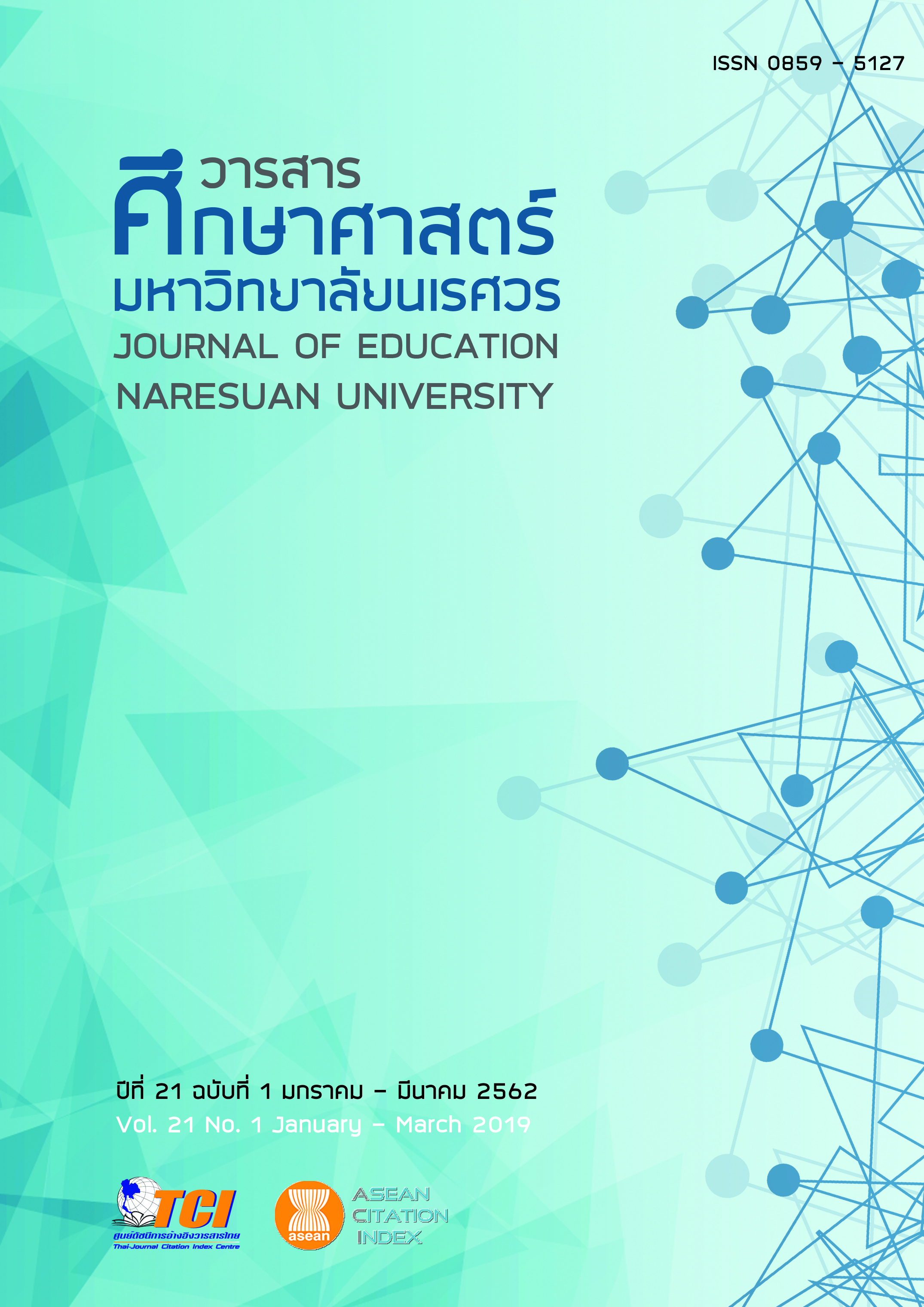ผลการจัดกิจกรรมการเรียนรู้แบบพิพาทเชิงสร้างสรรค์ที่ส่งเสริมความสามารถในการคิดเชิงวิพากษ์ของนักเรียนชั้นมัธยมศึกษาปีที่ 4 (THE EFFECT OF CONSTRUCTIVE CONTROVERSY METHOD TO ENHANCE CRITICAL THINKING ABILITY FOR GRADE 10 STUDENTS)
Main Article Content
Abstract
การวิจัยครั้งนี้มีจุดมุ่งหมายเพื่อเปรียบเทียบความสามารถในการคิดเชิงวิพากษ์ของผู้เรียนที่เรียนด้วยกิจกรรมการเรียนรู้แบบพิพาทเชิงสร้างสรรค์ ระหว่างก่อนเรียนและหลังเรียนและเปรียบเทียบความสามารถในการคิดเชิงวิพากษ์ของผู้เรียนที่เรียนด้วยกิจกรรมการเรียนรู้แบบพิพาทเชิงสร้างสรรค์ หลังเรียนกับเกณฑ์ร้อยละ 70 ของนักเรียนชั้นมัธยมศึกษาปีที่ 4 กลุ่มตัวอย่างคือ นักเรียนชั้นมัธยมศึกษาปีที่ 4 ภาคเรียนที่ 2 ปีการศึกษา 2559 โรงเรียนเตรียมอุดมศึกษา ภาคเหนือ จำนวน 38 คน โดยใช้แผนการจัดการเรียนรู้และแบบทดสอบวัดการคิดเชิงวิพากษ์ ดำเนินการวิจัยโดยใช้แผนการจัดการเรียนรู้จำนวน 3 แผน เป็นเวลา 15 ชั่วโมง วิเคราะห์ข้อมูลโดยใช้สถิติ ค่าเฉลี่ย () ส่วนเบี่ยงเบนมาตรฐาน (S.D.) สถิติ t – test แบบ dependent และ สถิติ t – test แบบ one samples test ผลการวิจัยสรุปได้ดังนี้
1. นักเรียนชั้นมัธยมศึกษาปีที่ 4 ที่เรียนด้วยการจัดกิจกรรมการเรียนรู้แบบพิพาทเชิงสร้างสรรค์ มีความสามารถในการคิดเชิงวิพากษ์หลังเรียน ( = 12.74 , S.D. = 1.57) สูงกว่าก่อนเรียน (
= 7.39 , S.D. = 1.42) อย่างมีนัยสำคัญทางสถิติที่ระดับ .01
2. นักเรียนชั้นมัธยมศึกษาปีที่ 4 ที่เรียนด้วยการจัดกิจกรรมการเรียนรู้แบบพิพาทเชิงสร้างสรรค์ มีความสามารถในการคิดเชิงวิพากษ์ หลังเรียน ( = 12.73, S.D. = 1.57) สูงกว่าเกณฑ์ร้อยละ70 (
= 11.20) อย่างมีนัยสำคัญทางสถิติที่ระดับ .01
THE EFFECT OF CONSTRUCTIVE CONTROVERSY METHOD TO ENHANCE CRITICAL THINKING ABILITY FOR GRADE 10 STUDENTS
The purposes of this study were to compare critical thinking ability before and after learning of students using Constructive Controversy and to compare critical thinking ability after learning of students using Constructive Controversy to the criterion.
The sample used in the study were 38 Mattayomsuksa4 students of triamudomsuksa School of the North during the second semester of academic year 2016. The instrument consisted of the three Constructive Controversy plans and a Constructive Controversy test. The experiment lasted for 15 periods and the data were statistically analyzed by using mean, percentage, standard deviation and t-test. The findings were as follows:
1. The students’ critical thinking abilities after using Constructive Controversy were higher than those before using Constructive Controversy at .01 level of significance.
2. The students’ critical thinking abilities after using Constructive Controversy were statistically higher than the 70 percent criterion at .01 level of significance.
Article Details
The owner of the article does not copy or violate any of its copyright. If any copyright infringement occurs or prosecution, in any case, the Editorial Board is not involved in all the rights to the owner of the article to be performed.
References
Aubkam, S. (2009). Learning provision emphasizing critical thinking and using social issues grade level 2 students, Sacred Heart College, Chiang Mai Province (Doctoral dissertation). Chiang Mai: Chiang Mai University. [in Thai]
Bickford, J. (2011b). A comparative analysis of two methods for guiding discussions surrounding controversial and unresolved topics. Eastern Educational Journal, 40(1), 33-47.
Chansawang, S. (2015). Keep an eye on the "social problems" of parallel economic growth. Retrieved on November 20, 2015, from https://www.bangkokbiznews.com/blog/detail/634442 [in Thai]
Chareonwongsak, K. (2003). Critical thinking (6th ed.). Bangkok: Success Media. [in Thai]
Danial A. Feldman. (2002). Critical thinking (Seubsahakan, V., trans). Bangkok: Explanation. [in Thai]
Feldman, R. (1996). Understanding psychology. New York: McGraw – Hill.
Inleang, W. (2015). The comparison of self-esteem by using constructive controversy and the conventional approach of Mattayumsuksa 3 Students (Master thesis). Phitsanulok: Naresuan University. [in Thai]
Kaewananta, P. (2004). Study of critical thinking skill in sex education of grade level 3 students at Wachiravit School, Chiang Mai Province (Independent study). Chiang Mai: Chiang Mai University. [in Thai]
Daniels, Mats, & Cajander, Asa. (2010). Experiences from using constructive controversy in an open ended group project. Proceedings - Frontiers in Education Conference. S3D-1. 10.1109/FIE.2010.5673418.
Ministry of Education. (2008). Indicators social studies, religion and culture the basic education core curriculum 2008. Bangkok: Printing agricultural cooperative federation of Thailand. [in Thai]
Mulkum, S. (2004). Critical thinking instructional strategies. Bangkok: Picture Prints. [in Thai]
Sariwat, L. (2006). Thinking. Bangkok: Odeon Store. [in Thai]
Sutthirat, C. (2015). 80 innovative learning-oriented learning management (6th ed.). Nonthaburi: P Balance Design & Printing. [in Thai]
Yasukham, T., & Supasorn, S. (2012). Enhancement of learning achievement and critical thinking skills science by using inquiry learning activities of chemical reaction rate. Journal of Education Naresuan University, 14(2), 23-33. [in Thai]


